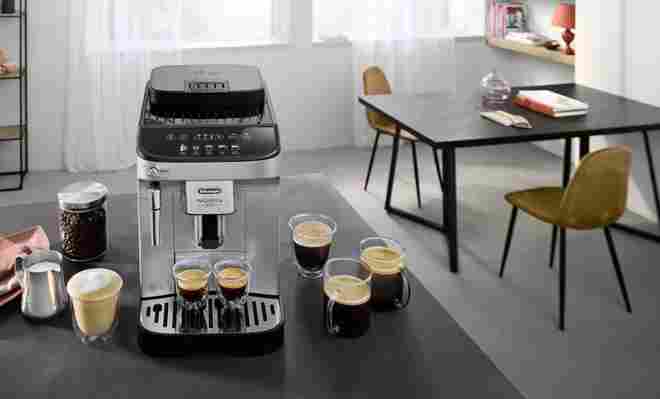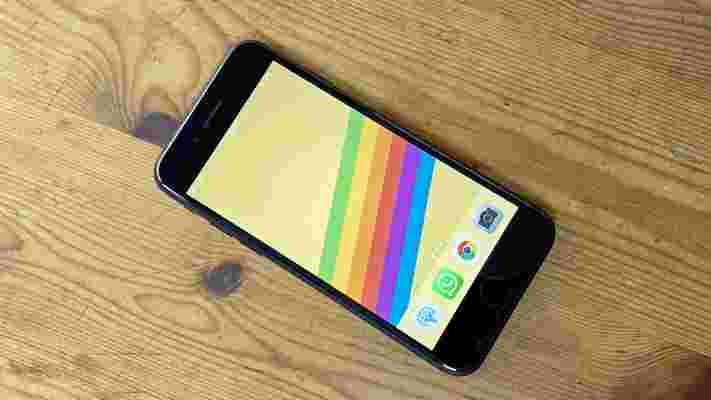There are so many ways to get your daily caffeine fix, but for a lot of us nothing can beat barista coffee delivered straight into your hand from the local artisan coffee shop on your way to work. However, times are changing and the increase in working from home is one pandemic trend that’s set to stay. So if your walk to work no longer takes you past a coffee shop you may be thinking about investing in one of the best coffee machines to brew your own tasty drinks at home.
True coffee aficionados will know that the best cup of coffee comes from freshly ground beans. Grinding coffee beans right before brewing your drink is a sure-fire way to create the finest flavor and aroma, as well as ensuring a thick rich crema on the top of the coffee. But grinding your own beans to the perfect size in a grinder before brewing your coffee is a lengthy process that just isn’t achievable in most people’s morning routines.
So the next best thing is a bean-to-cup coffee machine . They might come in at the pricier end of the coffee maker scale but investing in one of these to brew your morning coffee is the most hassle-free way to experience fresh barista-style hot drinks at home.
Read on to find out just how bean-to-cup coffee machines work, or if you want to get your hands on one of the best bean-to-cup machines now, check out these great deals for some of the best prices on the market.
What is a bean-to-cup coffee machine?
A bean-to-cup coffee machine takes care of the whole process from grinding the beans to pouring a delicious fresh coffee right into your favorite cup. These machines have an integrated grinder that grinds coffee beans to order, so your coffee is always made using the freshest possible grounds for the best flavor and aroma.
The most hands-off automatic bean-to-cup machines typically offer a selection of coffee types on a menu screen. You can choose between coffee shop favorites such as intense espresso, frothy cappuccino, silky latte, or flat white.
These models have a built-in milk carafe and will dispense perfectly texturized milk into the coffee to create barista-style drinks with minimal input from you, providing your caffeine fix without disrupting your morning routine. Often the milk carafe is removable so you can pop it back in the fridge between coffees and avoid the horror of sour milk in your drink.
For coffee lovers who want more control over the exact make-up of their drink, there are bean-to-cup coffee machines that feature a steam wand. These machines grind beans and dispense black coffee options including espresso, americano, and espresso lungo.
But the milk texturizing isn’t automated, you get to play barista and steam milk to your exact preference, whether that’s foam, no foam or somewhere in-between. These models give you the flexibility to create drinks just as you like them.

How does a bean-to-cup coffee machine work?
Bean-to-cup machines usually feature a hopper that you fill with your choice of coffee beans. Then, when you select your coffee from the menu on the machine, the correct quantity of beans is automatically dropped into the grinder and ground to the specific grind size required for the perfect coffee extraction.
Some machines have grind settings that can be adjusted to allow you more exact control over the finished flavor and aroma of your coffee, but this is usually something you’d adjust when the machine is new and then forget about.
After grinding, the coffee is dispensed from the grinder into the portafilter and compressed, in a process known as ‘tamping’, you’ll see your local barista doing this part by hand. This compression forms a disc of coffee, known as a puck, which if you have to do it by hand, can be tricky to get the pressure just right, so it’s great news that the machine takes care of this part. Because creating a perfectly compressed puck of coffee is crucial in extracting the most flavor from the grounds.
To create the drink, a predefined quantity of pressurized hot water is pushed through the puck of coffee and dispensed into your cup, usually within a specific time frame to guarantee the best flavor. But water temperature and coffee dose are amongst the settings that can be fine-tuned if you’ve got one of the best machines.
For coffee machines that have a manual steam wand, it’s then up to you to complete the drink by steaming and foaming your milk to the desired texture in a jug and adding it to the coffee. As we mentioned above, fully automatic machines take care of this part for you. They have a milk carafe which you need to fill up, but the rest is automated.
Depending on the drink you’ve selected, the coffee machine will heat and texturize the milk to the optimum consistency and dispense it into your cup on top of the coffee shot. Milk temperature, texture and foam levels are very subjective, and we all have different preferences, so the best automatic bean-to-cup coffee machines have customizable milk settings so that you can configure it to produce drinks that are exactly to your liking.

How to clean a bean-to-cup coffee machine?
Bean-to-cup coffee makers usually perform rinse cycles before turning off, some also do it when they’re first switched on too. These rinse cycles clean the coffee spout and the milk spout to ensure no residues dry on to any of these parts. The used coffee grounds are tipped into a bin at the end of brewing, this doesn’t need emptying daily, but often there’ll be a visual prompt to let you know when it’s too full.
Like most coffee machines, bean-to-cup machines feature automatic cleaning cycles for more thorough cleans and descaling and they prompt you to perform these cleans at regular intervals. Take note though, you’re usually required to use the brands own descaling or cleaning solution otherwise you risk invalidating the warranty.
Elden Ring won't run like ass after its latest update
Issues blighting the recently released Elden Ring across PC and PS5 are already being fixed in its latest patch. Initial reviews and comments about the games noted that performance on PC platforms was noticeably poor , and that some PS5 users were experiencing issues with their save game data if they left their console on sleep mode.
Elden Ring is the latest game from FromSoftware, a developer best known for making gruelingly difficult titles like the Dark Souls series and Bloodborne. Last week, FromSoftware made an announcement encouraging all PS5 players experiencing save data issues to shut down the console completely to try and avoid the bug while a full patch was being developed.
PC players also experienced framerate stuttering and other performance issues that have been attributed to the graphics card not being used correctly by the game.
As reported by WCCFTech , the previous 1.02.1 patch should have fixed these bugs, some were still being reported. Patch 1.02.2 claims to have resolved them now though, even referencing a specific issue where the game would shut down completely during a battle with the Fire Giant.
You can read the full patch notes over on the official Elden Ring Twitter account, but we've listed the relevant ones below:
PC patch:
PS5 patch:
Analysis: put down the pitchforks

FromSoftware has gained a reputation for creating pretty poor quality ports of its games to PC, and an initial wave of bugs isn't anything unusual for a new triple-A release. In fact, it's likely we'll see more issues pop up before everything is smoothed over, and it's worth bearing in mind that these issues are far from unique to the Demon Souls developer.
Big titles will inevitably run into some performance issues following the first few weeks following release as bugs that have slipped through the prior testing phase are discovered, but you shouldn't be too quick to make a judgment. After all, look at how well games like No Man's Sky have managed to turn itself around after a few months of development, and even Besthesda titles like Skyrim and Fallout have essentially rebranded some bugs as 'quirks' unique to the games.
If you're still on the fence, we would suggest you wait a few weeks for some additional patches to be released before you start installing the game onto your system, though most of the reviews have been overwhelmingly positive, and as with any bugs, you're not guaranteed to run into them during your own gameplay.
An iPhone SE 3 might arrive soon, so hold off on buying the iPhone SE 2020
Rumors suggest that the iPhone SE 3 could land soon, perhaps even in March , and the news that an Apple March event could happen in the first week of the month suggests it may not be long before we see a new affordable iPhone.
The iPhone SE 3 would replace the older iPhone SE (2020) , although rumors suggest the newer model won't be a huge upgrade.
It would be understandable, then, if you thought the new model will be your only option - when Apple launches new products, it often discontinues older ones, and it's possible that the company will take the SE 2020 off sale if it debuts the SE 2022.
However it's not that simple, and we'd actually recommend waiting, rather than buying the new iPhone as soon as it launches - here's why.
Not totally gone
When Apple discontinues products, it doesn't sell them on its website, but that doesn't mean you can no longer buy them.
Third-party retailers generally have large stocks of the devices, and we often see the likes of Amazon and Walmart selling years-old smartphones that they still have stocks of.
So it should be pretty easy to still buy an iPhone SE 2020, even if a new version debuts.

A lower price
There's also a rumor floating around that Apple won't discontinue the iPhone SE 2020 when the new model arrives, but actually slash it in price.
Apple has done this before on a few occasions, when it deems the older model still a valuable part of its lineup. It would depend on whether or not the SE 3 is a big step up from the second-gen model - rumors suggest it's not, but it could happen.
So waiting until after the March launch event could bag you a more affordable iPhone SE than buying one now.
Even if Apple doesn't officially lower the price of the iPhone SE 2020, we could see third-party retailers do so, in a bid to free up warehouse space for the newer models.
And it's not like Apple is going to increase the price of its old phone if it debuts the new one. So you're not going to lose money by waiting.
Maybe the iPhone SE 3 is good
There's another possibility, of course: the iPhone SE 2022 might be enough to sway you from the 2020 model entirely.
We've heard that it'll bring 5G connectivity, which the older SE models don't have, and it'll likely have a new and more powerful processor too.
And One analyst thinks the iPhone SE 3 could cost less than its predecessor - the $300 figure was raised - which would make it a really tempting affordable phone.
So if you're looking to buy a new, affordable iPhone, there are a few reasons to wait until the March event. In the tech world, waiting is often a smart move, and it rarely pays to jump in and buy a new devicce straight away.
